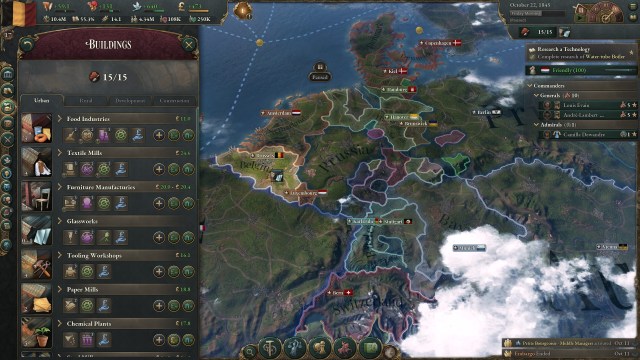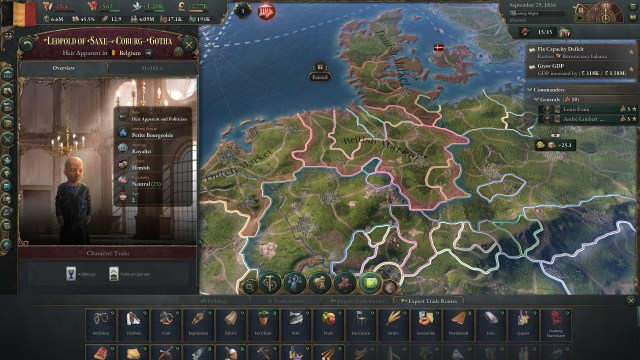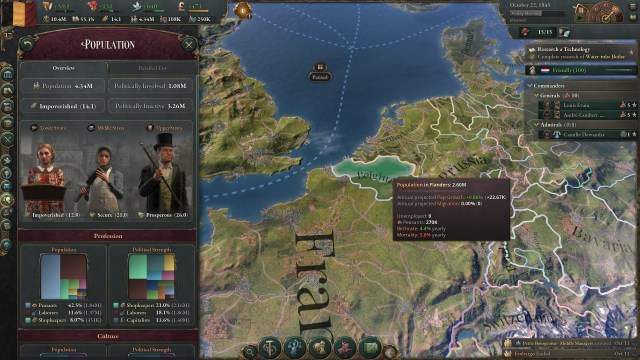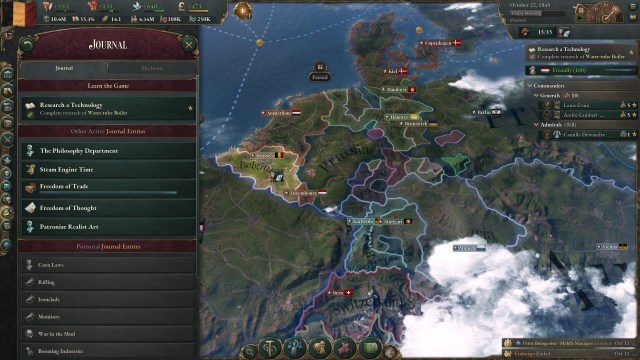Victoria approached me, with a fire in her eyes
I’ve been waiting for Victoria 3 for about as long as I’ve been interested in grand strategies. I’m a certified economics and international relations nerd. I also loathe most politicians as they have all sold us out for their own profit, but I still find politics fascinating. I’m essentially the person that the Victoria series is made for but try as I might, I was never able to get any more than skin deep into Victoria 2. So I waited patiently, for my turn in the pool.
I even got deep into Hearts of Iron IV for a bit, but it still wasn’t my precise cup of tea. Finally, last year, Victoria 3 was announced and even though it didn’t have a release window it was like the clouds had parted and I knew my time was coming.
Hype is a very dangerous thing, but Victoria 3 has lived up to everything I wanted it to be and even surpassed expectations in areas I didn’t think would work.

Victoria 3 (PC)
Developer: Paradox Development Studio
Publisher: Paradox Interactive
Released: October 25, 2022
MSRP: $49.99
Victoria 3 is the latest entry in the long-running library of grand strategy games from Paradox Development Studio. Whereas Hearts of Iron focuses on all-out war, and Crusader Kings puts lineage at its forefront, the Victoria series is more interested in the finer things of international relations: politics and economy. Starting in 1836, you take over as leader of one of the 200 nations with a centralized industry at the time. From there the choice is yours as to the world you will build. It’s escapism in its purest, nerdiest form and at times like these, I can’t get enough of it.
If Victoria 3 were to have a key defining base element, it is the population mechanic. You control the politics and industry of your nation, but you are kept in check by the populace of those you rule. Each of the citizens of your game world is simulated on characteristics such as education, religious and political beliefs, ethnicity, and profession. It is your job to improve the lives of your citizenry and keep them happy. Pops are considered to be happy when their income is high enough that they can afford their basic needs such as clothing and food, with higher-class citizens requiring more lavish goods.
The goods you produce and their supply and demand dictate their price in your market. If you can’t produce a good that your pops demand, you must trade for it using trade routes. If your citizens can’t afford the items they need or their political goals aren’t being realized, they’ll get upset and begin to revolt. It’s this economic and political ouroboros that defines the Victoria 3 experience in a nutshell.
If this all seems confusing on paper, fret not because there is an honest-to-goodness tutorial mode included with Victoria 3 and it works fantastically. Whether you’re starting out on your first grand strategy or are coming over from one of the many other Paradox series, nearly all concepts that you will come into contact with during your time in Victoria are explored through journal entries.
These journal entries can either point you in the right direction for how to accomplish your task or lay it out plainly step by step what you need to do. In addition to tutorials, Victoria 3 comes with interactive guides for the different ways to achieve success in the mid-19th century. Be it through hegemony, economic dominance, or even as a beacon of liberty in the era of fledgling democracy. It’s a very clever way to guide you into which countries fit the Victoria 3 model of gameplay, even though you are free to choose any of the available nations.
Even beyond the basic concepts you need to simply start the game, every simulated calculation, keyword, and concept is able to be expanded upon using what is called Nested tooltips. Simply hover over the word and a brief rundown of everything that goes into the concept is laid out onscreen. This peak behind the curtains works to both show you the nuts and bolts of how the game works, but also gives you an insight as to what you can do to improve your standing in the world. I spent a decent portion of my initial preview time with the game exploring these tooltips and it did more for me than 20 hours of Victoria 2 Youtube videos could ever do. So if you’re like me and struggling to get deep into Victoria 2, this is a fantastic place to start.

A Glorified Spreadsheet (and that’s OK)
The long-running joke for all grand strategy games is that they are basically spreadsheets with fancy GUIs and Victoria 3 is without a doubt the most spreadsheetiest of them all. Every choice you make affects something in your economy and that effect is usually presented in percentage form with an estimate of how it will affect your bottom line. It’s this simplified number go up or number go down presentation that makes decisions easy to make as you can see immediately get an idea of how they will affect your economy.
It’s also this presentation that can sometimes be a little misleading. Say you want to work on expanding your available trade routes. In order to do that you have to increase the number of boats you have available and then increase the size of your ports. The nested tooltip for these expansions will make it look like they will do nothing but lose you money. In reality, the expansion will more than likely make you money, so long as you are managing your market prices and keeping an eye on the available workforce.
Further hammering in the ongoing spreadsheet joke is the fact that Victoria 3 has the best base GUI in any Paradox game I’ve seen at launch since well…forever. Anyone who has tried to crack Victoria 2 will know that GUI was a mess of square boxes and bland menus. Victoria 3 uses superb design to draw your eyes and attention to the parts of the menus that are most pertinent with all relevant information presented in a concise and easy-to-read manner. I get similar feelings to playing around with a Microsoft Power BI dataset while browsing menus and gathering information to make decisions.
Additionally, there are lenses through which you can focus on particular aspects of your world like production, politics, and diplomacy. These lenses both offer quick information and the ability to act on them right on the world map. There are even line charts! I told you this was escapism at its nerdiest.

All of the fun of politics without some horned dude playing the fiddle at your side
While economics plays a huge part in the gameplay loop of Victoria 3, politics is what drives your population’s wants and needs. You inherit your country’s politics and a lot of the time there will be some things in there that you’ll want to change immediately. You won’t be able to do it alone, you’ll need the help of fellow like-minded individuals to work on passing the laws you put in place. It’s because of this that the politics of the games can feel a bit more restrained but it’s this restraint that really drives home the politician simulator feel of the game.
Even in a Monarchy, you will need to form a government made up of bureaucrats and politicians all belonging to different parties, each with different demands. Depending on how their demands are being addressed, they will either give you benefits or detractors to show their appreciation. You can’t please everyone and sometimes you need to put people in power that you don’t like, simply to progress your agenda. It’s a fantastic moral dilemma that the game places you in and I love the constant pulling on your moral compass.
Let’s say you want to change your voting process from landed voting to wealth voting in a long-term attempt to bring true democracy to your nation. In order to do this you will need to bring industrialists into your government makeup which will boost their popularity in the general population over time, helping to keep them in power. When the time comes to enact census suffrage, the industrialists will turn on you and work hard to keep their law in place, with events potentially occurring while the law is being enacted that could have long-term effects.
This event mechanic is very similar to the role-playing elements of Crusader Kings and feels a lot more weighty than any of the other decision-based prompts that I’ve seen outside of the Crusader Kings series. At one point I tried to push a law too early and it wrecked my favored party because of a blunder they pulled on the campaign trail that caused them to lose face for five years.

It’s the politics of the game where you really have to set a goal and work towards it in everything you do. It will take time but there’s a genuine sense of joy when a long-term goal comes to fruition. Take for example my long-term goal to get the trade union politician to a point where they were politically viable. In my game, they started with a popularity of less than 5%, which meant they were marginalized and therefore their needs didn’t come into account in the grand scheme of my nation. By using some of my authority I was able to bolster their support over a few years to the point where they entered the political sphere. From there they were off to the races as their power only grew thanks to me being able to work them into my government and enacting laws they wanted. It’s the weirdest way to get serotonin but I’ll take it.
War has changed
Your politics don’t have to stop at your borders. You are given a certain number of political spheres that you can interact with based on your trade policies and the amount of power you wield on the international stage. In these political spheres, you can bolster or hamper your relations with the nations within, join customs unions or trade agreements, and even declare rivalries. The larger you get, the more regions you can interact with and the further you can spread your influence. If politics isn’t working, it’s time to break out the diplomatic plays.
Through diplomatic plays you can force your views on other nations, but be wary of wannabe Teddy Roosevelts, nobody likes being bossed around. It works like this, you approach a nation and demand a change in its policies. It can be something as simple as giving up control of a region or port, to something more technical like changing their trade policy. 99% of the time, the country will tell you to F off and now you’re locked in a political standoff that has a time limit until it becomes war.
As the clock ticks down, you can make more demands and recruit other nations to your side while also doing a bit of saber-rattling by calling up your armies. You can even force nations that you have previously helped to join your side. The two sides will pivot and jockey for all the support they can get, trying to get one side to back down. If one side does back down, then the other side’s primary goal is automatically enacted. But if both sides don’t back down, the diplomatic play quickly descends into war, and then it’s up to the generals.
Unlike my time with the preview, I made sure to dig into the war mechanic a few times to see how it works as this change is probably the biggest departure from the typical Paradox formula. Whereas the tactical aspects of war were controlled directly by the player in pretty much every Paradox game before Victoria 3, you only control war from a high-level perspective by assigning your generals or admirals to different fronts. Each of your officers comes with their own personality and that dictates how they will fare on the battlefield. In my first attempt, I stupidly assigned a defensive general to an offensive front and he immediately got wiped out, despite having a numbers advantage. Whoops. I fared better in later attempts but it’s the type of thing you need to read into or else you’re going to have a bad time. You can also assign your admirals to damage the supply and trade network routes of your enemies, weakening their economy and cutting into the war machine.
For a lot of veterans of the Paradox Grand Strat library, this change is a controversial one. While I understand their concerns, after having played with it for a while, I don’t think a game like Victoria 3 needs the tactical war mechanic. It’s a game about politics and economy, and you are the head of state, not a general. Yes, some leaders of the time were known for their military prowess but to me, it’s not a deal breaker. The long-standing belief is that the tactical war element will be brought in as DLC in the future, but I really don’t want it. If I want to play general I have Hearts of Iron IV, but today I am a politician (blech).
The loss of autonomy also forces you to treat war as a last resort. When I lost one of the wars I waged, I lost hard. Gone was the only port that drove my trade routes and kept my population clothed and happy. I was also humiliated on the world stage and had to repay war reparations. I was, for all intents and purposes given a ceiling and I shan’t break through it. It reminded me of how costly war is in the board game Twilight Imperium, where even winning hurts. For some, this may be a turnoff, but for me, it only deepened the political simulation.
A Grand Tomorrow, because I spent all night playing it
Victoria 3 is very clearly not for everyone. It’s a lot of all menu navigation and long-term planning that sometimes amounts to watching bars progress on-screen. But for those that respond to that type of gameplay loop, Victoria 3 will provide countless hours of megalomaniac entertainment. Even for those that are new to the genre, I’ve yet to see a launch that is as inviting and welcoming to new players, while still maintaining the mechanics of previous games for returning veterans. Yes, the war mechanic might be considered “missing” by some, but in the interest of making a politician simulator, I do not think it is needed.
What is here though is a deep simulation where every aspect of your nation interweaves with itself telling a story that you built. I’ve never been this in love with a strategy game before. I finally found the one for me, and I won’t need another one for quite a long while.
[This review is based on a retail build of the game provided by the publisher.]













Published: Oct 24, 2022 11:00 am